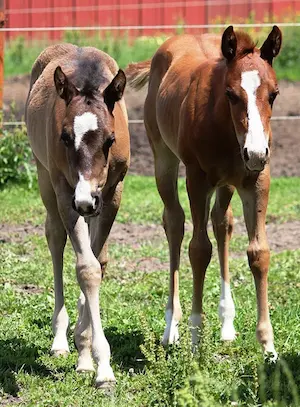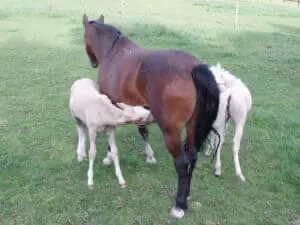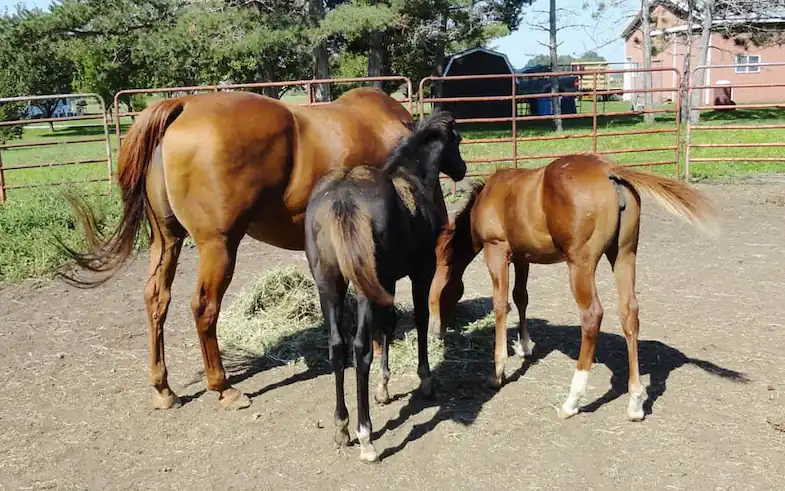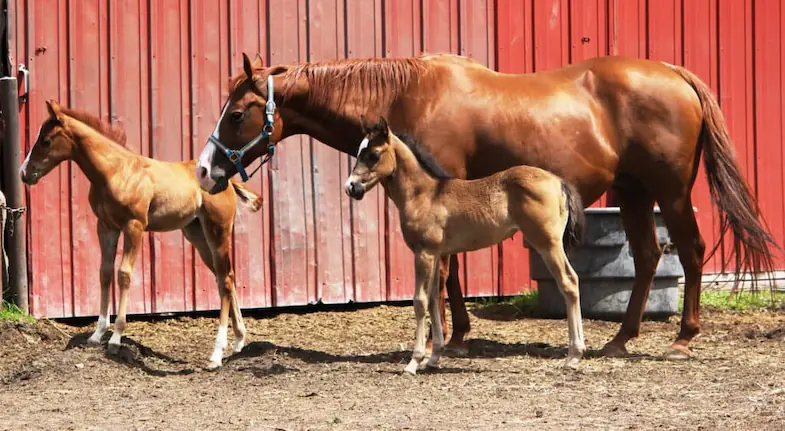With the natural breeding season beginning soon I started to wonder why we only see a single foal running alongside its dam. After all, cats, dogs, and many other animals give birth to multiple offspring after each breeding, so why don’t horses? With this thought in mind, I grabbed my laptop and began looking into whether or not horses can actually have twins (or even triplets for that matter). It was very difficult to find anything conclusive online so I did my own research into this and was amazed by what I found.
Can horses have twins? Like all other mammals, horses are capable of carrying twins but the chances of this happening are rare, while the likelihood of a mare giving birth to two healthy foals is even less likely, but that doesn’t mean to say it doesn’t happen.
Just because it’s possible for a horse to have twins though it doesn’t mean that it’s likely they will. With somewhere between 250,000 and 300,000 horses being born in the US alone every year you might think that there would be a lot of twins, especially when you consider that there’s a 1 in 10,000 chance of a mare carrying twins but this doesn’t tell you the chances of a mare successfully giving birth. Most mares will naturally abort the twins within the first two months, those that don’t though will likely do so after the eighth month with only 20% of all mares carrying twins actually giving birth. Sadly though most of those births are stillborn or with one (or both) foals dying within the first two weeks.
The chances of a horse carrying identical twins (which is when a fertilized egg splits and both embryos carry exactly the same genes) are even rarer, in this case, the chance of a mare carrying identical twins is approximately 1 in a million – literally!! Just because the chances are extremely slim though doesn’t mean it doesn’t happen. In 2018 a horse owned by Tania Mackee (at Gassons Farm Stud in Exeter, UK) gave birth to healthy identical twins, while this was incredible in itself, what was really amazing was that the same horse, known as Destiny, gave birth to more healthy twins less than two years later. You can read more about the identical twins and the subsequent twins here.
How does a twin pregnancy happen in horses?
While it is possible for a horse to carry identical twins the vast majority of equine twins are known as fraternal twins (or non-identical twins). Unlike identical twins which are a result of a single egg splitting and producing two identical embryos that carry exactly the same genes (hence them being identical), fraternal twins occur when two eggs are released and fertilized. Known as double ovulation, fertilization can happen at the same time or up to 24 days apart.
If the eggs are fertilized days apart then in most cases the first foal is likely to be the strongest and biggest and will be the most likely to survive.
How can you tell if a horse is carrying twins?
You might think that a horse carrying twins will be a lot bigger than one carrying just one foal but this isn’t the case, and even if it was it would be difficult to tell in the early stages of the pregnancy. Around ten years ago a veterinarian would have used a rectal ultrasound but, while they’re still used today, a portable ultrasound can be used to detect the presence of two embryos with around 99.999% certainty.
On the rare occasion that twins are missed in all prenatal examinations then the first visual sign to look out for is early udder development. In a normal pregnancy, this is likely to happen between three and six months but in horses carrying twins, the udder will start to expand within the first three months.
Once a horse reaches the latter stages of the pregnancy though it can be difficult to detect twins because the foals will tend to be aligned in the uterus, therefore only allowing one heartbeat and thorax to be seen.
What are the risks of a horse having twins?
There’s a good reason why most twin pregnancies don’t make it to full term and why those that do are less likely to be successful. Regardless of how many foals the mare is carrying her body will produce the same amount of nourishment and nutrition (as well as oxygen), this means that if there’s more than one foal they will be competing with each other which typically results in both of them being smaller, weaker and in some cases underdeveloped.
Horses were only really meant to carry one foal at a time which means that if they’re carrying two a lot more stress is put on their bodies, and the uterus, in particular, it’s also more likely to cause birthing problems. If the pregnancy goes to plan and both foals are born alive they’re still likely to be frail and can suffer from weak lungs and kidneys. There’s also a risk that their cuboidal bones (small joint bones that are the last to convert from cartilage to bone) will be incomplete, this can lead to the joints collapsing and ultimately degenerative joint disease.
While there have been a number of successful stories of horses giving birth to healthy twins this is sadly the exception to the rule which is why most horses will naturally abort the pregnancy or ‘reduce’ one of the foals. If this doesn’t happen though your veterinarian can help to reduce the smallest foal, this must be done within the first seventeen days of the pregnancy (although some mares will do it themselves before they reach 30 days). Reducing the smaller embryo is often the best option because it gives the stronger embryo the chance to develop fully and increases the chance of a healthy birth and foal.
Reducing (sometimes called pinching) an embryo is done by entering the horse’s rectum, finding the uterus, and then pinching it until the vesicle (a small sack of fluid) breaks. This may sound cruel but the mare doesn’t feel anything (and in most cases it’s done without any sedation) and the reduced embryo will be naturally absorbed back into the body, the stronger embryo will then have a far greater chance of survival.
Can a horse have triplets?
Around 1 in every 300,000 equine births will be triplets although, as with twins, the chance of those foals being born alive and healthy is very narrow but again it does happen. Back in the late 1980s an eleven-year-old American Buckskin gave birth to three foals after a 300-day gestation. While she gave birth on her own without any help the foals (two fillies and a colt) were all very weak and needed intensive care almost immediately. All of the foals weighed less than 35 pounds and sadly one died after just 4 days with another being euthanized after 24 days due to persistent metatarsal fractures. The third foal, however, was small but otherwise healthy and was eventually discharged from intensive care, you can read more about the triplets here.
I hope you found this article helpful. If you did I’d be grateful if you could share it please as it would really help me.
Recommended products
Over the years I have tried hundreds of different horsey products, from various blankets and halters to different treats. Some I’ve loved, others I’ve hated but I thought I’d share with you my top all-time favorite products, the ones I never leave the yard without. I’ve included links to the products (which are in no particular order) that I really think are great.
- Horse Knots by Reference Ready – If you’re like me and enjoy pocket reference guides then you’ll love this knot tying guide. These handy cards can easily fit in your pocket or attach to the saddle for quick reference. They’re waterproof, durable and are color coded to make them easy to follow.
- Mane ’n Tail Detangler – Even if you never show your horse you’ll need to detangle his tail from time to time (and possibly his mane too) which is always a challenging chore! I’ve found that if I run a little bit of detangler through my horse’s tails every few days it stops them from getting matted up and makes combing them easy, even if they’re coated in mud. I don’t know if I should admit to this or not but it also works wonders on my hair.
- TAKEKIT Pro clippers – Over the years I’ve tried a lot of different clippers and while some were obviously better than others I found these to be by far the best. They are heavier than a lot of other clippers but for me, that’s a good thing, it makes them feel more sturdy and hardwearing. On top of that they have a range of speeds so are just as good for clipping your horse’s back as they are his face. I also like the fact that they come in a handy carry case but that’s not for everybody. The company that makes them is super good and incredibly helpful too, a real bonus these days. The only thing I wasn’t keen on was the fact that it doesn’t come with any oil, but that’s not a major problem as it’s not difficult to buy lubricant.
- Shire’s ball feeder – There are so many boredom buster toys out there but I like to use these every day, regardless of whether or not my horses are bored. I find that it helps to encourage my horses to problem solve by rewarding them with treats (or pieces of fruit) but it also mimics their natural grazing behavior which helps to keep them calm and de-stressed.
- Horse safe mirror – This is a strange one that many people are surprised about but I like to put horse safe mirrors in the trailers as well as in the quarantine stalls. It helps to prevent the feeling of isolation by giving the impression of other horses being around. Being herd animals horses can get extremely stressed when they feel that they’re on their own but with these stick-on mirrors, they believe that at least one other horse is with them.
- Rectal thermometer – I know this isn’t glamourous at all but it’s vital for your horse’s well-being to be able to check their temperature and a rectal thermometer is the easiest way of doing this which is why I’ve added it to the list.
Shopping lists
I’ve also put together a few shopping lists of essential items that I’ve found helpful over the years. I’ve broken the lists down into different categories rather than put everything in one massive list 😉





